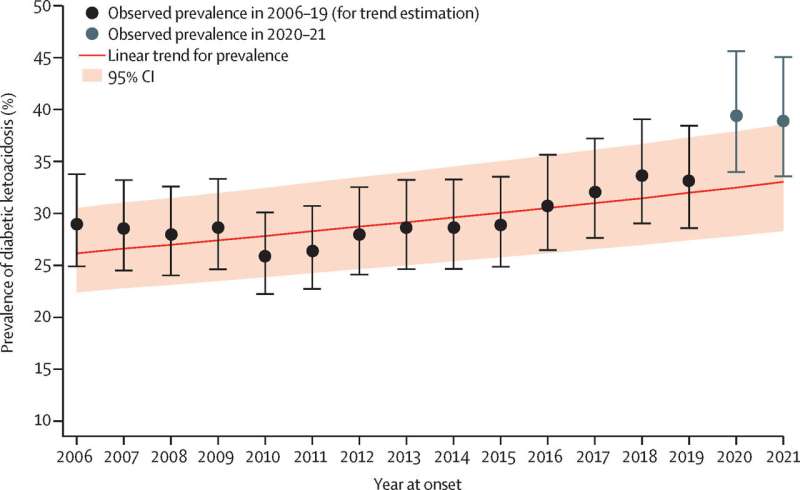Prevalence of diabetic ketoacidosis at diagnosis of type 1 diabetes in children in 2020 and 2021 compared with the trend from 2006 to 2019. To analyze predictors for diabetic ketoacidosis at diagnosis of pediatric type 1 diabetes in 2020 and 2021, we used a log-binomial model based on data from 2006 to 2019 with age groups, sex, and year as predictors, including countries as random intercepts. The error bars indicate the corresponding 95% CI of the observed diabetic ketoacidosis prevalence. Credit: The Lancet Diabetes & Endocrinology (2022). DOI: 10.1016/S2213-8587(22)00246-7
If children and young people have already developed metabolic imbalances (diabetic ketoacidosis) at the time of diagnosis of type 1 diabetes (T1D), this can result in complications such as extended stays in hospital, poorer long-term control of blood sugar levels, brain edema, or even a higher mortality rate.
During the COVID-19 pandemic, diabetes centers across the world observed an increased prevalence of diabetic ketoacidosis in diagnosed cases of T1D. DZD researchers, together with international colleagues, investigated whether the number of diabetic ketoacidosis cases associated with the diagnosis of pediatric T1D increased more than expected. To achieve this, they analyzed the number of diabetic ketoacidosis cases before and during the pandemic.
International multi-center study
The team evaluated data from 13 national diabetes registers (Australia, Austria, Denmark, Germany, Italy, Luxemburg, New Zealand, Norway, Sweden, Slovenia Czech Republic, U.S. [Colorado], and Wales).
The study cohort consisted of 104,290 children and young people aged between 6 months and 18 years old who were diagnosed with T1D between January 1, 2006 and December 31, 2021. The observed prevalence of diabetic ketoacidosis during 2020 and 2021 was compared with predictions based on the years before the pandemic (2006–2019).
The increase in the prevalence of diabetic ketoacidosis during the pandemic was greater than expected
Between 2006 and 2019, 23,775 of 87,228 children had diabetic ketoacidosis when diagnosed with T1D (27.3%). The mean annual increase in the prevalence of diabetic ketoacidosis for the entire cohort between 2006 and 2019 was 1.6%. During the pandemic, the numbers were significantly above the predicted prevalences. In 2020, the adjusted observed prevalence of diabetic ketoacidosis was 39.4% (predicted prevalence 32.5%) and 38.9% in 2021 (predicted prevalence 33.0%).
"The increasing prevalence of diabetic ketoacidosis associated with the diagnosis of type 1 diabetes in children is a global problem. There was already an increase in prevalence before the COVID-19 pandemic. During the pandemic, this increase was even greater," says DZD scientist Prof. Reinhard W. Holl from Ulm University.
The authors of the study point out that providing a comprehensive explanation of the classic symptoms of T1D in childhood to the general public, those active in the childcare or daycare settings, and primary care physicians could help raise awareness of the symptoms of T1D. Furthermore, public health measures could be used, for example, in implementing a general islet-cell autoantibodies screening program for children to reduce the number of dangerous metabolic imbalances.
The research was published in The Lancet Diabetes & Endocrinology.
More information: Niels H Birkebaek et al, Impact of the COVID-19 pandemic on long-term trends in the prevalence of diabetic ketoacidosis at diagnosis of paediatric type 1 diabetes: an international multicentre study based on data from 13 national diabetes registries, The Lancet Diabetes & Endocrinology (2022). DOI: 10.1016/S2213-8587(22)00246-7
Journal information: The Lancet Diabetes & Endocrinology
Provided by Deutsches Zentrum fuer Diabetesforschung DZD






















